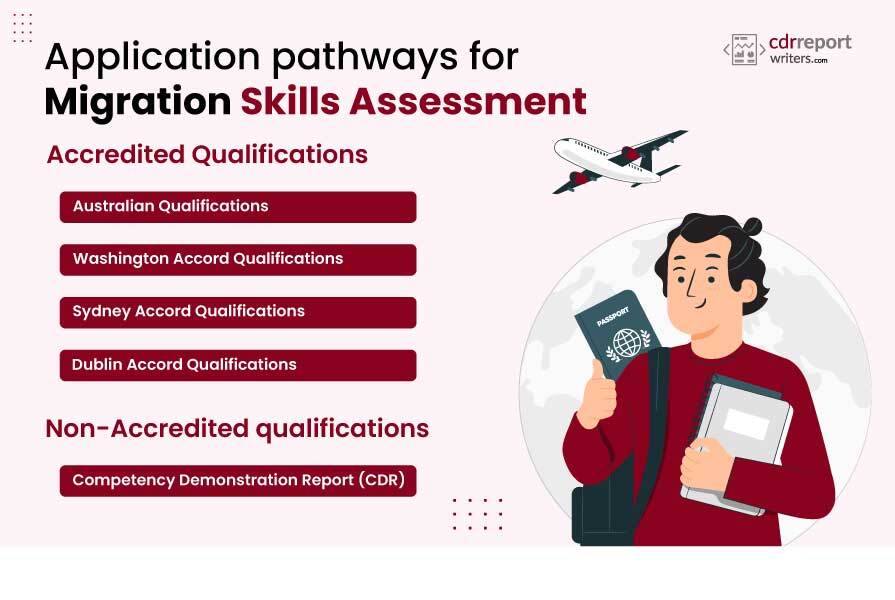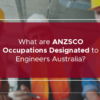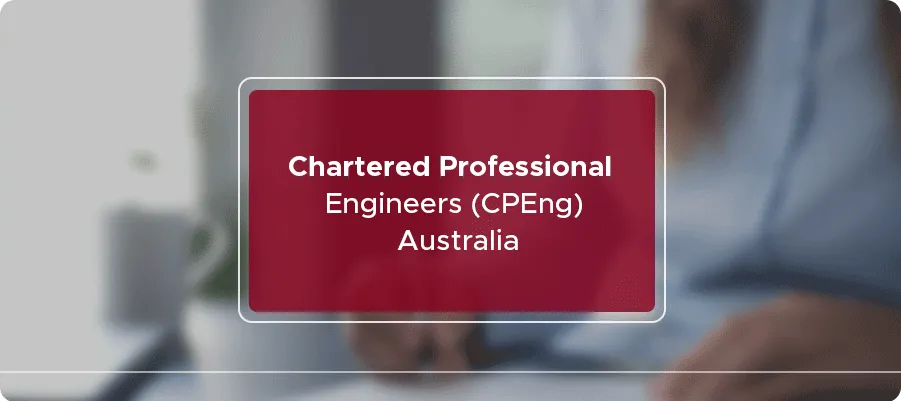
Application Pathway for Migration Skills Assessment
The Migration Skills Assessment Program (MSA) is for engineers applying for a permanent skilled migration visa for Australia. It is a detailed skills assessment consisting of five application pathways for migration skills assessment to determine comparability with Australian standards for a skilled worker in your nominated occupation.
Migration Skills Assessment process for all engineers who do not possess Australian qualifications or qualifications from countries that are signatories of the Washington Accord, Sydney Accord, or Dublin Accord. Those who fall in that category have to go through the CDR pathway.
CDR refers to the Competency Demonstration Report, where engineers try to prove to the Australian authorities their skills and competencies in the engineer of their level and eligibility for skilled migration to Australia.
Engineers Australia (EA) Skills Assessment is a widely recognized pathway for engineers looking to migrate to Australia. Engineers Australia, the professional body for engineers in Australia, manages this assessment. The assessment process includes a review of the candidate’s qualifications and work experience to ensure they meet the standards set by EA.
The assessment process ensures that the engineers migrating to Australia are qualified and have the appropriate expertise to meet the standards set by EA. Another essential resource for engineers who migrate to Australia is the Migration skills assessment booklet.
This booklet provides detailed information on the skills assessment process for engineers seeking to migrate to Australia. It includes information on the documents required, the assessment process, and the assessment outcome. A booklet is a helpful tool for engineers as it outlines the steps they need to take and the criteria they need to meet.
The Migration Skills Assessment (MSA) Booklet, issued by the Department of Home Affairs (DHA), is another critical resource for those looking to migrate to Australia. It outlines the process for assessing the skills of migrants and provides information on the documents required, the assessment process, and the outcome of the assessment.
This booklet helps the migrants to understand the process and the requirements they need to meet to migrate to Australia. Engineers Australia Skills Assessment Timeline is crucial for engineers looking to migrate.
Engineers Australia has a specific timeline for the skills assessment process, from the application submission to the outcome of the assessment. Applicants need to be aware of this timeline and plan accordingly, ensuring they are prepared and submit all the required documents on time.
Five application pathways for migration skills assessment in Australia:
It usually is categorized into two sections: Accredited qualifications and Non-accredited qualifications.

Accredited qualifications
The accredited qualifications met the standard of Australia and are recognized through formal international agreements. Accredited qualifications lead to the professional qualification you want in the industry or plan to work.
- Australian Qualifications
- Washington Accord Qualifications
- Sydney Accord Qualifications
- Dublin Accord Qualifications
Non-Accredited qualifications
The non-accredited course is the courses that are not connected to an external accreditation or professional body. These are excellent learning courses for a new skill set or building on your existing proficiencies.
- Competency Demonstration Report (CDR)
Accredited Qualifications
The courses approved by the legislative and professional authorities and meeting Australia’s standards are accredited courses. The accredited qualifications are Australian and overseas engineering qualifications, which are recognized through formal international agreements.
Accredited qualifications lead to the professional qualification you want in the industry or plan to work. It can help you to get ahead in your chosen career with the specific position and title of your degree.
You must enroll for an accredited qualification if you require a recognized credit-bearing certificate or diploma. The accredited programs for engineers can be of three-level, i.e., Professional Engineers, Engineering Technologist, and Engineering associates.
Australian Qualifications
The Australian Government designs the Australian Qualifications Framework to ensure that the qualification titles across the country are consistent and represent the same high education standards.
- According to the MSA Booklet, Graduates of accredited Australian engineering programs are eligible for migration skills assessment via the Australian Engineering Qualifications application pathway.
- The students who commence their studies within a fixed period of time are referred to graduate from an accredited program. It is also referred to as an (F) after the commencement date of an accredited program.
- Provisional accreditation is referred to as a (P) after the commencement date and indicates that full accreditation is expected but not guaranteed. The applicants with Provisional accreditation must submit the Competency Demonstration Report (CDR) for the assessment process.
- Engineers Australia has the right to request an English Language test result like IELTS, TOEFL, and PTE from the applicant applying to have their skills assessed by Engineers Australia.
- But the applicants who are native English speakers and applicants who have completed the Australian undergraduate engineering qualification or Ph.D. program from Australian University are excused from the requirement of the English Language Test.
Objectives of Australian Qualification
- Provide support and maintain accessible pathways to education
- Enhance and assist diversity of training both now and in the upcoming days
- Provide national economic performance through well-developed training courses
- Framework for regulation across the education and training sectors
- Set up international education framework and standards
1. Washington Accord Qualifications
The qualifications publicly listed as accredited by the relevant signatory will be considered for recognition via the Washington Accord. You should have the same qualification title as the title on the published list of accredited qualifications for the relevant signatory.
The Washington Accord needs the minimum academic requirements of qualifications, which are broadly comparable to an Australian 4-year bachelor’s degree in engineering.
2. The Sydney Accord
The qualifications publicly listed as accredited by the relevant signatory will be considered for recognition via the Sydney Accord. You should have the same qualification title as the title on the published list of accredited qualifications for the relevant signatory.
The Sydney Accord needs the minimum academic requirements of qualifications, which are broadly comparable to an Australian three-year Bachelor of Technology degree in engineering.
3. The Dublin Accord
The qualifications publicly listed as accredited by the relevant signatory will be considered for recognition via the Dublin Accord. You should have the same qualification title as the title on the published list of accredited qualifications for the relevant signatory.
The Dublin Accord needs the minimum academic requirements of qualifications, which are broadly comparable to an Australian two-year Advanced Diploma or Associate Degree in engineering.
Non-Accredited Qualifications
The non-accredited course is the courses that are not connected to an external accreditation or professional body. These are excellent learning courses for a new skill set or building on your existing proficiencies.
Non-accredited courses focus on equipping the student with specific knowledge and skill set and will add value to your CV. The non-accredited qualification doesn’t lead to pursuing a professional career with possible credentials behind your name; for that, you have to get accredited qualifications.
The qualifications from Australia or countries full signatories to the Sydney Accord, Dublin Accord, and Washington Accord are only approved by MSA. The others whose countries are not accredited by Engineers Australia (EA) have to submit the Competency Demonstration Report (CDR) to EA for migration skills assessment.
Learn More: Become an Australian Permanent Resident 👨🎓✈️
Things you must understand about the non-accredited courses
- Non-accredited courses concentrate on providing the student with distinguishing knowledge and skills
- Non-accredited courses are more inexpensive than professional courses
- You can examine them that will help in either your current or future career
- They are usually of shorter period
- Additionally, Non-accredited courses are much more affordable in comparison with professional courses.
- Usually, non-accredited courses don’t have professional recognition, but you can add it to your Curriculum Vitae (CV).
Competency Demonstration Report (CDR)
The engineers who want to migrate to Australia must prepare the Competency Demonstration Report (CDR). If you are a native Australian, you don’t need CDR unless you are an immigrant from a nation that is not a signatory or a member of the Sydney Accord, Washington Accord, or Dublin Accord.
If you want a permanent residency visa under skilled migration, then CDR should be prepared accurately by following the guidelines mentioned in the MSA booklet by EA. The applicants who write the CDR must prove that their engineering knowledge and competencies match the Australian standards. CDR is the report that contains the group of documents that displays your engineering skills and knowledge of the English language.
The engineers are asked to submit the CDR to go through the migration skill assessment process. The Institute of Engineers Australia is responsible for checking the CDR.
So, EA checks the CDR carefully and thoroughly, and your selection depends on how perfect your CDR looks. A complete CDR Report includes a CV, Continuing Professional Development (CPD), Three Career Episodes, and Summary Statement.
Guaranteed Positive Skills Assessment!
Get High-Quality CDR at an Affordable Price
Documents needed to be submitted with CDR
- The updated CV or Resume
- The official and complete academic transcripts and results
- The result of IELTS, TOEFL or PTE
- Academic degree certificate
- Latest passport size photo
- The documents to prove your employment, as mentioned in your CDR Report’s career episodes, and employment evidence for the last year.
- If applicable, your professional registration certificate.
- A copy of your current passport
Recommendations for writing an ideal CDR Report
Writing an ideal Competency Demonstration Report (CDR) requires much effort and time. But by following specific guidelines, you can make it much quicker and in the best way possible. Below is the information which you need to write a perfect CDR report:
- Before writing the CDR Report, read the guidelines in the Migration Skills Assessment (MSA) booklet of Engineers Australia.
- Wisely select the topics or projects for your Career episodes that demonstrate your high-level skills. Following the guidelines of Engineers Australia, write these complete episodes.
- Inside the career episode, you need to mention your capabilities and skills instead of group work. Also, the three career episodes should not relate to each other.
- All statements and episodes of CDR Report must get written in the Australian English language without plagiarism and grammatical errors. If you have your report in another language, don’t forget to translate it into Australian English.
- The summary statement is one of the essential sections most assessors read, so it should be written correctly without any errors.
- Your content must be unique with no plagiarism and errors, as Engineers Australia (EA) is very strict with these errors. So, take a reference and write your report by yourself.
Learn More: Get maximum points in Australian Immigration. 👨🎓😀
Wrapping up
In conclusion, the Five Application Pathways for Migration Skills Assessment provide a comprehensive approach to assessing the skills of individuals seeking to migrate to Australia.
The Engineers Australia skills assessment, the Migration Skills Assessment booklet, and the MSA booklet all play an essential role in determining an individual’s qualifications and experience while providing a transparent and standardized process for assessing their skills.
This approach ensures that only those with the necessary skills and qualifications can migrate to Australia, contributing to the country’s continued growth and development.
We, from CDRReportWriters, provide different services for applicants who want skilled migration to Australia though they come under non-accredited qualifications.
Our experts or a team of engineers will help you draft the ideal career episodes, summary statements, CPD writing, and Resume/Curriculum Vitae (CV) of the Competency Demonstration Report (CDR), which gets considered a pivotal part of the assessment of Engineers Australia.





